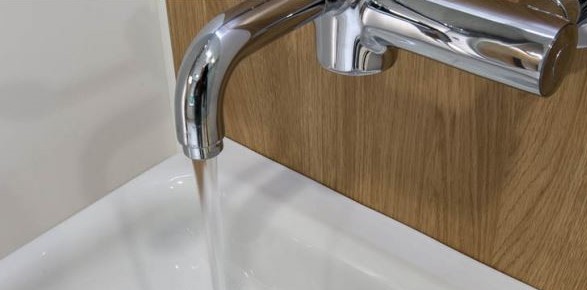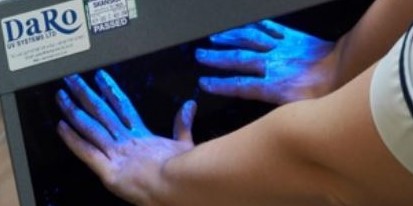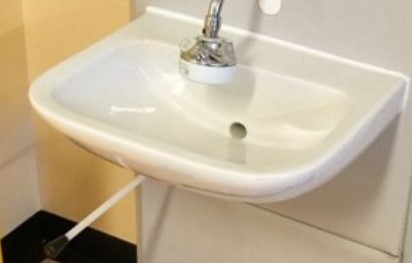While alcohol hand rub is the preferred method for hand decontamination, when hands are visibly dirty or have been in contact with an organism resistant to alcohol use of a hand wash station (HSW) is required. In the UK operation of HWSs should be hands-free, in general requiring either sensor or elbow operation.
This requirement for hands-free operation of hand wash stations is fundamental to preventing the HWS becoming a source of cross infection. Cross infection in hospital can be very dangerous, which is why prevention of cross infection is important. Staff using a HWS will have highly contaminated hands so hand operation will inevitably contaminate a surface such as a conventional tap. If after washing hands the user touches the same surface to turn the outlet off, then hands will become re-contaminated.
There is also a further danger: the tap itself could also become contaminated, in turn leading to contamination of the water supply further upstream to cause systemic issues within the plumbing system. This applies to pseudomonas as well. Pseudomonas in water supply from travelling in water pipes can lead to water infections in the water system.
Pros and cons of sensor and elbow operation
Sensor- and elbow- operated outlets have their own advantages and disadvantages.
With sensor-operated outlets there is a concern that the increased complexity predisposes to biofilm formation (bacterial growth). Additionally, because there is no standard for placement of the sensor for operation of these taps, there may be a learning curve for users during which hands may make contact with the end of the outlet and introduce contamination. However, a major benefit or sensor-operated outlets is that they can be programmed to flush automatically, a potential advantage in areas of infrequent use where a HWS is still required.
Elbow-operated taps are generally preferred, have been in existence for much longer and therefore might be expected to be a tried and tested solution. They cost less and are thought to represent a lower risk of biofilm formation despite invariably being fitted with a thermostatic mixer valve or tap in healthcare facilities, even when a risk assessment would show this as unnecessary.
Pseudomonas aeruginosa and legionella control in healthcare facilities prevent infections due to water exposure. Legionella risk assessment services are available.
Elbow-operated outlets in practice
What is the evidence that elbow operated outlets work in practice? The minimum requirements for using elbow operated outlets correctly are listed in Table 1. It is implicit that not only users but also design and installation teams understand the function and requirement for an elbow operated outlet if it is to be used correctly.
Table 1. Requirements for elbow operated outlets to be used correctly
1. Correct design
2. Correct installation
3. Staff training on correct use
Correct design
The elbow operated lever needs to be long enough and readily accessible to be operated using an elbow. Accessibility is best afforded when the lever is angled forward from the body of the outlet towards the user. Some manufacturers recommend that the elbow operated lever is in line with the main body of the outlet i.e. parallel to the inspection panel behind. In my experience this makes it extremely difficult to engage an elbow with the lever. It is both too far away and there is insufficient space between the inspection panel and lever. Furthermore, when in this position, the placement of the hand detergent or towel dispensers above the outlet further prohibit the use of the elbow.
The latest British Standard BS8580-2:2022 Part 2: Risk assessments for Pseudomonas aeruginosa and other waterborne pathogens —Code of practice recommends: “Elbow operated outlet handles need to be set up so elbow can readily engage with lever”.

Figure 1. Bird's eye view of outlet Shows view looking down from above onto an outlet demonstrating the correct placement of elbow-operated lever positioned forward of the main body of the outlet.
An additional advantage of sensor-operated outlets is that they always draw on both the hot and cold water supplies. With elbow-operated outlets, many staff only move the elbow lever a short distance, which may not ensure an adequate draw on the hot water supply. With some manufacturers the elbow lever needs to be rotated 180° to maximise hot water flow, but this rarely happens in practice.
Some manufacturers have now designed out this problem. For example, in Armitage Shanks's Markwik 21+ products, since 2016 the lever must be fitted at 45° forward for correct operation and also has a shorter total 90° rotation to achieve maximum rotation. An arrow on the assembly facilitates correct alignment and this is emphasised in the instructions.

Correct installation
Failures to understand the importance of correct set-up of the elbow lever by installation teams may result in at least 40% of outlets being set up incorrectly. In some cases, even when the outlet is well-designed, manufacturers' layout instructions do not adequately describe or stress that the angle of set-up is key to the proper performance of the outlet.
Staff training on correct use
Most training on hand washing emphasises technique— staff are not trained on how to use either a sensor or elbow-operated outlet, even though the name 'elbow-operated' outlet would suggest that use should be intuitive. Studies show that more than 90% of individuals use their hands to turn on elbow-operated outlets and that more than 60% use their hands (re-contaminating) to turn the flow of water off. The elbow operated lever now becomes a highly touched object and a source of cross contamination.

Figure 2: The Glo™ boxHand hygiene training is mainly based around technique, an example of which is the Glo™ box (see picture above). A hand cream (which fluoresces under ultraviolet light) is applied to hands. The person is then asked to wash their hands with soap and water, dry them and then the hands are inspected under UV light. Poor hand wash technique is shown by fluorescence from un-removed cream.
But matters are compounded further. Elbow-operated outlets are frequently installed flush with the inspection panel behind, negating their operation through use of elbows. Even though installed incorrectly, this deficit is not recognised, understood or reported so remains in place.
Compliance with hand hygiene is disappointingly low. Even when allowing for staff usage of a HWS, there is a more than 60% chance that it will have be used incorrectly – making the real figures for compliancebecome worryingly low.
What is the answer?
An effective solution also needs to take into account human nature and likely compliance. Grabowski et al found that only 4% of visits to a HWS were for the right purpose. Kearney et al when looking at the risk of acquisition of highly antibiotic resistant organisms from HWSs in an ITU setting found the most effective solution was engineering out the risk i.e. removal of the basin. The least effective solution was guidance and training. Antibiotic resistant bacteria and infections in hospitals can use this solution to prevent spreading and cross-infection.
To even start to get this right, this requires: manufacturers, installation teams and infection control to understand the correct set-up of an elbow-operated lever. Once infection control personnel understand this, they can then devise training for the healthcare staff. Engineering out the risk is likely to be the most effective solution and sensor operated outlets would appear to offer a significant advantage. However,in the past we have had knee-operated HWSs (see Figure 3). Perhaps this is theway forward.
While hand decontamination is seen as the single most effective intervention to prevent cross infection, we are failing to get the basic design and use of HWBs optimised to ensure effective and safe hand washing practices.
Whilst clinical hand wash stations are required to be operated hands-free, hand washbasins in patient communal bathrooms are hand-operated as they would be in most households across the UK. After going to the toilet, turning on an outlet with contaminated hands will deposit organisms, which are likely to re-contaminate hands when turning the outlet off. Turner et al report a CPE outbreak in a communal bathroom linked to contamination of a hand operated tap.

Figure 2: Knee operated outlet
There is no logic to the current operation of outlets used for hand washing where hands are used both to turn on and off the outlet. If paper towels are available, the WHO recommend they should be used to dry hands first and then used to turn off the outlet to prevent re-contamination of hands. However, paper towels are rarely available in domestic settings. There are implications not just for hospitals, but also for public health.
In healthcare, the current use and design of HWBs permits deposition of faecal organisms on the handle used to operate the outlet.
The 2016 O'Neill report forecasts the end of the antibiotic era by 2050, which will inflict an overwhelming burden both financially ($100 trillion) and on human life with 10 million excess deaths year-on-year. A recent report for the year 2019 already shows the excess of one million deaths per year due to antimicrobial resistance. Unless we get hand washing right, these highly antibiotic resistant organisms, which are often carried in the human gut, will inflict a deadly burden on humanity.
To find outmore about antimicrobial resistance, infection control and hand washing –download your free copy of our Looking Deeper Journal here: https://www.idealspec.co.uk/resources/whitepapers.html